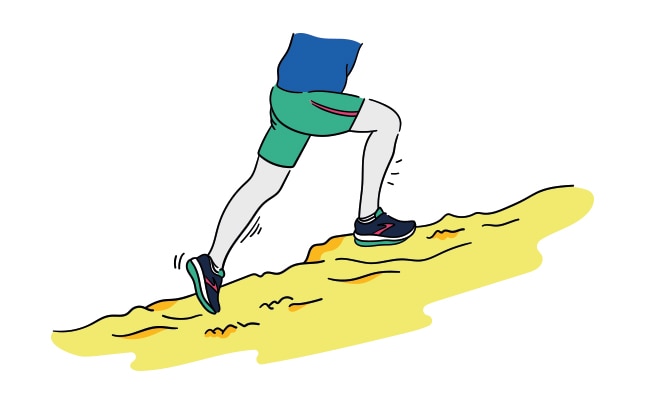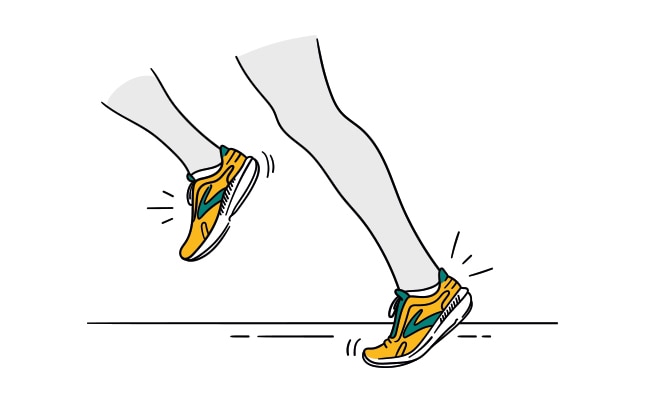Discover the right running shoe to prevent shin splints

Continuing our pain prevention series, we get down to the root causes of shin splints and find out how the right footwear can make all the difference.
What are shin splints?
Shin splints are a common complaint, affecting almost 35% of runners and other endurance athletes. The main symptom is familiar to many—pain and tenderness along the front of the lower legs—but fewer runners really understand this painful condition's causes and treatments.
Shin splints, or medial tibial stress syndrome (MTSS), is the swelling of the tendons that connect your muscles and bones together in your lower leg. It's generally thought to be caused by strenuous repetitive activity and exacerbated by a lack of stretching beforehand or afterwards. The pain caused by shin splints generally subsides shortly after exercising but can become continuous if left untreated, potentially even leading to a stress fracture.

Risk factors for shin splints
Because shin splints are caused by repetitive stress on the shinbone and connective tissues, they often occur in runners who have recently increased the frequency, intensity, or duration of their runs. Beginner runners are also at risk as their lower limbs adapt to new stresses and challenges.
But it's not entirely down to your running schedule. Flat feet may make you more vulnerable to shin splints (we've got shoes for that), as will high arches.
The ground beneath your feet is the other main factor here. Running on uneven terrain places a great strain on your lower body, making shin splints more likely and giving trail runners heightened risk. Unfortunately, running on hard surfaces also increases the chances of shin splints. That's why the right running shoes are arguably the most effective way for every type of runner to prevent shin splints.

How to treat shin splints?
Although we're going to focus on footwear as the most effective remedy, your choice of running shoes for shin splints isn't the only way to prevent and treat them. Take it from Monica Queen, a physical therapist and USA Track & Field Level 1 coach who’s had her fair share of shin splints in her 26+ years of running:
When I was a collegiate runner, treatment often consisted of ice baths for approximately 15 minutes, or an ice cup massage. Now that I’m a physical therapist, I sometimes still use the ice cup massage to help ease the pain. To perform an ice cup massage, take a foam or paper cup (like a Dixie Cup) and fill it almost to the top with water, leaving about a quarter of an inch unfilled. Place in the freezer. Once all of the water is frozen, you can tear off the top of the cup and flip it over so the ice can be placed against your skin. Get in a comfortable position with your leg extended, place a towel under your lower leg, and use small circular motions along the shin that is sore. This can be done for about 5-10 minutes.
Other treatment options recommended by Queen include:
- Stretching the muscles that are limiting the range of motion in the foot or ankle.
- Strengthening the muscles that will help with stabilization for running.
- Temporarily reducing your mileage or taking a break from running.
- Getting your posture, foot alignment, and gait assessed by a physical therapist to address structural or mechanical issues.

Running shoes for shin splints and comfort
All running shoes are cushioned, but the purpose and feel can vary a lot. Some are built to maximize springiness and speed, while others emphasize shock absorption and, as a result, comfort. If you've ever had shin splints or consider yourself at risk, switch to running shoes for shin splints with ultra-cushioned midsoles to protect your feet and legs.
Brooks running shoes with our proprietary DNA LOFT technology, for example, absorb minor changes in surface texture—such as cracks and pebbles—and disperse impact away from the body. The result? The plushest cushioning of any of our running shoes for shin splints, a consistently soft ride for the duration of your run, and some welcome relief for your shins.
Our newest innovation, DNA LOFT v3, takes cushioning tech to the next level by infusing nitrogen for an even softer, lighter, and more responsive experience. Its proprietary blend of EVA foam, rubber, air, and nitrogen results in a unique compound that increases softness, decreases weight, and improves energy return—all without sacrificing durability. It all adds up to a better experience for your sore shins.

Our best running shoes for shin splints
Because comfort is the aim of the game when it comes to shin splints, we recommend running trainers for shin splints that maximize cushioning and support. Key features to look for are ample cushioning, support and a proper fit. That's why each of the following features DNA LOFT, our softest midsole technology compared to DNA AMP (highest energy return), BioMoGo DNA (balance of softness and responsiveness), and DNA FLASH (built for speed).

1. Glycerin
Cushioning has always been the calling card of our Glycerin shoes, including DNA LOFT v3 in the latest models. Designed for track and road running, Glycerin shoes provide super soft cushioning, neutral support for supinators (as opposed to overpronators), and air mesh uppers for a secure, comfortable fit.
2. Ghost
Comfort is a key component of our best-selling running shoe. With soft, balanced cushioning in an updated midsole and smooth transitions from landing to toe-off, this shoe will help you ghost your shin splints as you go from striding to gliding. We've also improved the fit of the upper for distraction-free comfort mile after mile.
3. Adrenaline
An established favorite for more than 20 years, our Adrenaline running shoes offer soft landings on even the toughest roads. They're also packed with comfort-enhancing innovations, including a 100% DNA LOFT midsole and our GuideRails® technology that keeps excess movement in check to support your feet, knees, and hips even when you get tired.
Hit your stride in some running shoes against shin splints
Whether you've already had shin splints or you simply want to avoid them as you ramp up your training, the right shoe will make all the difference. In fact, the more miles you begin to run, the more important it is to take every possible step to stay healthy and comfortable.
Your choice of shin splint running shoe is completely down to your preference, but you can rest (and run) assured that every Brooks shoe is lab-proven and runner-tested for you to run happy. Just remember that nothing lasts forever—you should replace your shoes with a fresh pair every 400 miles!
More gains, less pain, and good riddance to shin splints. Check out other informative articles in our pain prevention series , as well as a wealth of running tips, insights, and advice on our blog.